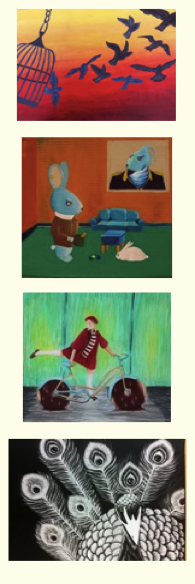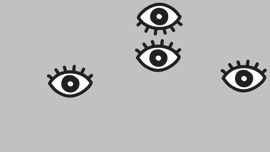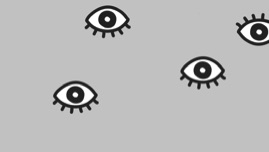
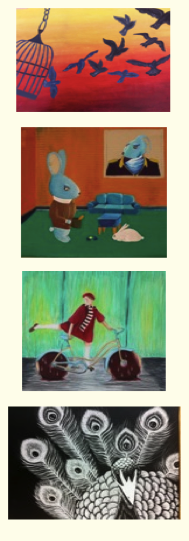
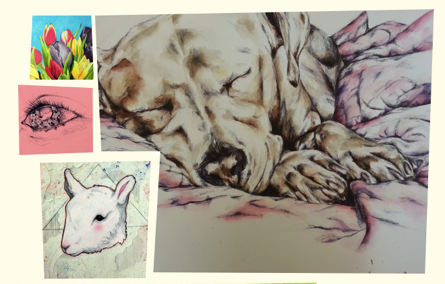
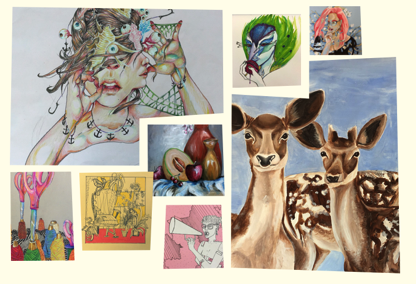
Visual Arts
The Fine Arts classroom moves beyond one dimensional instruction and into a productive and complex interdisciplinary context. The program prepares students for further studies should they choose to make the fine arts a career; and to be an informed viewer with refined audio and visual perception to enrich a creative life. We nurture alternative ways of knowing and learning, and serve the widely divergent needs of all students.
Grade Level(s): 9,10,11,12
Graduation Requirement: Performing/Fine Arts
Courses Mrs. Urrechaga teaches:
STUDIO ART 1 (W25 & W26)
Students experiment with the media and techniques used to create a variety of two-dimensional (2-D) artworks through the development of skills in drawing, painting, printmaking, collage, and/or design. Students practice, sketch, and manipulate the structural elements of art to improve mark making and/or the organizational principles of design in a composition from observation, research, and/or imagination. Through the critique process, students evaluate and respond to their own work and that of their peers. This course incorporates hands-on activities and consumption of art materials.
STUDIO ART 2 (W27) *Teacher Recommendation
Students develop and refine technical skills and create 2-D compositions with a variety of media in drawing, painting, printmaking, collage, and/or design. Student artists sketch, manipulate, and refine the structural elements of art to improve mark-making and/or the organizational principles of design in a composition from observation, research, and/or imagination. Through the critique process, students evaluate and respond to their own work and that of their peers. This course incorporates hands-on activities and consumption of art materials.
STUDIO ART 3 HONORS ( W28) *Teacher Recommendation
Students demonstrate proficiency in the conceptual development of content in drawing, painting, printmaking, collage, and/or design to create self-directed or collaborative 2-D artwork suitable for inclusion in a portfolio. Students produce works that show evidence of developing craftsmanship and quality in the composition. Through the critique process, students evaluate and respond to their own work and that of their peers. Through a focused investigation of traditional techniques, historical and cultural models, and individual expressive goals, students begin to develop a personal art style. This course incorporates hands-on activities and consumption of art materials.
PORTFOLIO HONORS (W33) *Teacher Recommendation
Students work in a self-directed environment to develop a portfolio showing a body of their own work that visually explores a particular artistic concern, articulated and supported by a written artist's statement. Artists may work in, but are not limited to, content in drawing, painting, printmaking, and/or mixed media that emphasizes line quality, rendering of form, composition, surface manipulation, and/or illusion of depth. Students regularly reflect on aesthetics and art issues individually and as a group, and focus on expressive content that is progressively more innovative and representative of the student's artistic and cognitive growth. In keeping with the rigor expected in an accelerated setting, students' portfolios show personal vision and artistic growth over time, mastery of visual art skills and techniques, and evidence of sophisticated analytical and problem-solving skills based on their structural, historical, and cultural knowledge. Students are self-directed and display readiness for high levels of critical thinking, research, conceptual thinking, and creative risk-taking. This course incorporates hands-on activities and consumption of art materials.
AP ART & DESIGN (W34, W35 & W36) *Teacher Recommendation
The AP Art and Design course framework is composed of course skills, big ideas, essential questions and enduring understandings, learning objectives, and essential knowledge. AP Art and Design skill categories delineate overarching understandings central to the study and practice of art and design. Each of the three skill categories consists of skills that encompass foundational to advanced learning over the span of the course. Students need to develop, practice, and apply these skills in a variety of contexts.
The AP 2-D Art and Design course framework is made up of three big ideas. As always, you have the flexibility to organize the course content as you like.
Big Idea 1: Investigate materials, processes, and ideas.
Big Idea 2: Make art and design.
Big Idea 3: Present art and design.
W34: 3 dimensional
W35: drawing
W36: 2 dimensional
** Honors and Advanced Level Course Note:
Advanced courses require a greater demand on students through increased academic rigor. Academic rigor is obtained through the application, analysis, evaluation, and creation of complex ideas that are often abstract and multi-faceted. Students are challenged to think and collaborate critically on the content they are learning. Honors level rigor will be achieved by increasing text complexity through text selection, focus on high-level qualitative measures, and complexity of task. Instruction will be structured to give students a deeper understanding of conceptual themes and organization within and across disciplines. Academic rigor is more than simply assigning to students a greater quantity of work.
